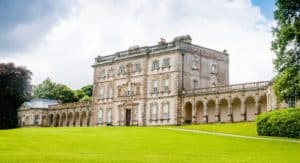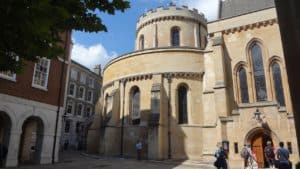The Cultural Significance of the Irish Bodhrán: Unveiling Its Historical Roots and Modern Resonance

Updated On: April 16, 2024 by Maha Yassin
The bodhrán is special in Irish culture and is emblematic of the nation’s rich musical heritage. This traditional frame drum, often crafted with a wooden body and a goatskin head, serves as an instrument and a resonant symbol of Ireland’s history and identity. The rhythms of the bodhrán have been the heartbeat of Irish music for generations, its percussive tones underpinning dances and enlivening songs across the Emerald Isle. Its distinctive sound is as much a part of Ireland’s cultural tapestry as the fiddle’s lilting melodies or the uilleann pipes’ mournful airs.
Over the years, the bodhrán has evolved from a simple peasant’s instrument into a sophisticated tool for musical expression, embraced by traditional and contemporary musicians alike. Regardless of its form, the bodhrán consistently plays a unifying role in Irish music, gathering people to celebrate their cultural heritage. This versatile drum mirrors the dynamic spirit of Ireland, adapting to the nuances of modern music while maintaining its deep ancestral roots. Today, the bodhrán is central to Irish traditional music and features in fusion genres and world music, showcasing its global influence and the adaptive nature of Irish culture.
Historical Context and Origin
The Irish bodhrán holds deep cultural significance, with a history that weaves together ancient traditions and the evolution of Irish music. Its journey from the past to the heart of modern Irish identity exemplifies the resilience and adaptability of cultural practices.
Ancient Roots and the Celts
The bodhrán’s antecedents can be traced back to frame drums used by the Celts. These instruments are often featured in religious ceremonies and rituals. The bodhrán, as we know it, may have emerged as a farm tool before being adapted into a musical instrument.
Christianity and Folk Traditions
As Christianity spread through Ireland, the bodhrán was absorbed into folk practices, bridging pre-Christian traditions and the new religious landscape. Its presence in Irish traditional music grew, accompanying dances and social gatherings, reflecting a potent symbol of community cohesion.
19th Century Revival
In the 19th century, a resurgence of interest in Irish traditional culture included the bodhrán. This revival safeguarded the drum’s presence in Irish music and helped cement its role as an emblem of our cultural legacy. Now an integral part of Irish identity, the bodhrán’s evolution mirrors Ireland’s historical trajectory.
Design and Construction

In approaching the design and construction of the bodhrán, we’re delving into a craftsmanship realm where tradition meets precision. Utilising natural materials and time-honoured techniques, the bodhrán makers have refined the drum into a fine piece of musical artisanship.
Frame and Skin
The bodhrán frame is traditionally crafted from wood, often bent and shaped to form a seamless circular band that provides the instrument’s structural strength and ergonomic grip. Goatskin is the most commonly used animal skin for the bodhrán, with its texture and thickness contributing to the unique sound quality. Before fitting, the skin undergoes preparation to ensure it’s pliable and resonant once affixed to the frame.
- Materials: Wooden frame, usually ash or birch; natural goatskin.
- Construction: The wooden frame is crafted by a bodhrán maker, with edges rounded for comfort; it is skin-treated and tensioned across the frame.
Tension and Tunability
The tensioning of a bodhrán is pivotal for perfecting its sound. Earlier bodhráns featured a fixed skin, where tension was manipulated by warming or moistening the skin. Modern designs incorporate tunability, allowing us to alter tension via hardware fitted around the frame. This advancement has allowed greater control over the instrument’s tonal range and pitch.
- Tuning Systems: Crossbar (traditional) versus hardware tuners (modern).
- Mechanisms: Bodhrán makers have innovated mechanisms for tunable designs, ensuring reliable performance.
Our understanding of the bodhrán’s construction underlines its cultural significance and the meticulous work involved in its making, from selecting materials to the final tuning process.
Playing Techniques and Styles
In this section, we explore players’ skilled methods to bring the bodhrán’s unique sound to life. We delve into how the instrument is held, the techniques for using the tipper, and the complex beats that define its playing styles.
Holding and Hand Position
To play the bodhrán, a musician must first master how to hold the drum and position their hands correctly. Our dominant hand typically grasps the tipper or beater—a stick used to strike the drum—while the other hand applies varying pressure levels to the drum’s skin from the inside to control tone and resonation. Precise control of both hands is crucial for articulating the nuanced sounds that characterise Irish music.
Use of the Tipper and Beater
The tipper, also known as the beater or cipín in Irish, extends the player’s rhythmic intent. Its rapid movement across the bodhrán head produces the core beats that drive a tune. Various playing styles exist, some employing the traditional simple stick, while others might use a brush or multi-ended stick to create diverse textures.
Rhythmic Patterns and Signature Beats
Signature beats and rhythmic patterns are central to the bodhrán’s character within Irish music. Rhythmic patterns on the bodhrán range from straightforward quarter-note beats to complex, syncopated patterns incorporating jigs, reels, and hornpipes. Each playing style produces distinct signature beats that support the musical ensemble with both subtlety and drive.
Musical Role and Ensemble Integration

In the tapestry of Irish music, the bodhrán’s distinct rhythmic pulse is crucial, both as a solo instrument and within ensembles. Its versatile role enhances the dynamic range of performances, resonating as the heartbeat of traditional melodies.
Solo Performances
The bodhrán stands out as a profound musical voice when featured in solo performances. Musicians often display a variety of playing techniques, from soft, resonant touches that evoke gentle landscapes to vibrant, commanding strikes that echo the spirit of Irish dance. The instrument’s solo capability allows for a rich exploration of rhythm and texture, holding the audience’s attention with its distinctive, earthy timbre.
Traditional Group Settings
In traditional group settings, the bodhrán integrates seamlessly with other instruments, such as the fiddle, tin whistle, and uilleann pipes, to create a full-bodied musical ensemble. It’s the rhythmic foundation upon which melodies are layered, creating an infectious energy that defines much of Irish traditional music. As an ensemble member, the musician with the bodhrán is more than a timekeeper; they are catalysts for the ebb and flow of the music’s tempo, adding depth and character to the collective performance.
Evolution of the Bodhrán
The bodhrán has undergone significant changes, from a simple farm instrument to a recognised staple of Irish folk music, influenced by key musicians and evolving performance styles.
From Peasant Rhythms to Stage
Originating in the rural Irish setting, the bodhrán was primarily used in a folk context, often within the confines of small community gatherings. Its evolution began as the instrument gained visibility, moving from the background of peasant merrymaking to becoming a centrepiece in Irish musical performances. It was not until the mid-20th century that the bodhrán started appearing on world stages, thanks to the revival of Irish folk music.
Influence of Pioneer Musicians
Musicians like Seán Ó Riada played an instrumental role in elevating the bodhrán from a farmhand’s pastime to the concert halls. Ó Riada, as the founder of Ceoltóirí Chualann, included the bodhrán in his ensemble, which showcased its potential alongside other traditional instruments. Following in his footsteps, Peadar Mercier popularised the bodhrán as a professional instrument. More recently, artists such as John Joe Kelly have continued to innovate, using complex rhythms and techniques to show the bodhrán’s versatility. Their contributions have firmly established the bodhrán as an iconic symbol of Irish music.
Cultural and Symbolic Significance

The Irish bodhrán holds a profound place in the cultural tapestry of Ireland, symbolising national identity and playing a pivotal role in contemporary Irish culture.
National Identity and Gaelic Revival
The bodhrán is more than a mere musical instrument; it is intrinsically linked with Irish culture and heritage. Embodying the spirit of the Gaelic revival, this traditional drum has become a potent symbol of Irish national identity. Its usage is often connected with the Irish word for party – ‘céilí’, where it frequently accompanies dances and gatherings, reinforcing its cultural resonance.
The Bodhrán in Contemporary Culture
In contemporary culture, the bodhrán has transcended its folk origins to feature in modern music genres, showcasing the adaptability of Irish heritage. It is celebrated in Ireland and on the global stage, where it’s recognised as a symbol of Celtic music. This increase in popularity underscores the bodhrán’s role as a beloved emblem of Ireland’s enduring musical legacy.
Regional Variations and Styles

In exploring the cultural tapestry of Ireland, we encounter various regional expressions of music, each with its distinct flair. The bodhrán, as part of this rich cultural fabric, exhibits influences that vary by locale, particularly notable in playing styles.
The Kerry Style
The Kerry style of bodhrán playing, which we find in the southwest region of Ireland, is characterised by its energetic and flamboyant approach. This style often uses the tipper, a type of drumstick, to perform rapid, intricate rhythms that can be as lively as the famed Kerry dancers.
Differences Across Ireland
Across Ireland, one will notice regional variations in bodhrán playing, reflecting Irish music’s diverse styles and genres. Each region adds its unique flavour to the instrument’s technique, ranging from the subtle, complex rhythms favoured in the quieter, more lyrical Clare style to the bold and forceful strikes found in the Northern style, illustrative of the dynamic range the bodhrán covers within the spectrum of Irish traditional music.
Innovations and Modern Techniques

The bodhrán has evolved remarkably, with modern innovations influencing playing styles and instrument construction. These advances have enriched the instrument’s versatility and cemented its role in contemporary music.
Refined Playing Methods
In recent years, we’ve witnessed significantly refined playing techniques enhancing bodhrán’s expressive capabilities. Johnny McDonagh, a pivotal figure in the bodhrán’s development, pioneered methods like playing on the rim and the backslide, lending a new level of complexity to the rhythms produced. Additionally, updated teaching methodologies have emerged, focusing on the nuances of wrist action and finger control, thus enabling players to produce an intricate array of sounds.
Contemporary Bodhrán Making
Craftsmanship has embraced modernity; today’s bodhráns embody a fusion of tradition and innovation. Makers use cutting-edge materials and design principles to enhance the instrument’s acoustics and playability. Tunable bodhráns are a prime example, allowing musicians to adjust the skin tension on the fly, tailoring the pitch to the music’s requirements. Moreover, recordings of the bodhrán have benefited from high-quality equipment, capturing the subtleties of each performance and solidifying the instrument’s place in the modern recording industry.
Prominent Bodhrán Musicians and Makers
In exploring the world of traditional Irish music, we recognise the bodhrán’s distinct resonant beats, carried forward by exceptional musicians and makers alike. These artists have been integral in the instrument’s fabrication and rhythmic lifeblood.
Influential Players
One of the most renowned bodhrán players is Tommy Hayes, whose intricate playing techniques and rhythms breathe life into the music. Hayes has mastered the bodhrán and contributed significantly to the contemporary soundscape of Irish music, making him a significant figure among prominent musicians.
Mícheál Ó Súilleabháin, another legendary figure, has been influential in bridging the gap between Irish traditional music and classical music. His genius includes interpreting the bodhrán’s sound in a way that merges tradition with a modern twist, marking his prominence in the ever-evolving genre.
Craftsmen and Their Craft
The craftsmanship of a bodhrán maker is a revered skill that echoes the rich cultural heritage of Ireland. With their deep understanding of the instrument’s acoustics, these craftsmen shape the bodhrán’s identity. Their craft involves selecting the perfect materials and employing techniques that ensure each bodhrán looks the part and sounds exceptional.
Among the craftsmen, select bodhrán makers distinguish themselves, becoming almost as celebrated as the musicians who play them. Their dedication to the art and meticulous attention to quality contributes significantly to the musical tapestry of Ireland and beyond. Each of their creations is a vessel through which the heartbeat of Irish music is sustained and cherished.
Educational Resources and Learning the Instrument
When mastering the Irish bodhrán, the journey involves blending skill acquisition and tapping into rich educational resources. We have detailed some avenues for aspiring players to deepen their knowledge and refine their technique.
Workshops and Tutorials
Workshops are an invaluable way to gain hands-on experience. Ireland has numerous festivals and gatherings where one can engage in bodhrán workshops. These sessions are typically led by seasoned musicians and provide a mix of foundational techniques and advanced playing styles. For those who can’t make it to Ireland, many cities worldwide host Irish music workshops where the bodhrán is a frequent focus.
Tutorials, in-person and online, offer structured learning opportunities for all levels. Renowned bodhrán players often produce video series or step-by-step guides, allowing learners to practice independently. McNeela Music is one source that delves into the bodhrán’s history and also offers enthusiasts learning materials.
Online Communities and Forums
A wealth of knowledge and support can be found in online communities and forums. Novices and experts gather on these platforms to exchange tips, share experiences, and provide feedback. Apart from elucidating the cultural significance of the bodhrán, websites like IrishCentral often have comment sections and associated forums where one can ask questions and learn from peers.
Online forums dedicated to the bodhrán are frequented by a global community eager to assist with queries on everything from tuning the instrument to mastering complex rhythms. They are also great spaces for discovering more educational resources, including video links, instructional articles, and further reading or viewing recommendations.
Remember, learning the bodhrán is a dynamic process and engaging with these educational resources can greatly enhance one’s playing skills and cultural understanding of this iconic Irish instrument.
The Bodhrán in Fusion Genres and World Music

The bodhrán has transcended its traditional Irish roots, establishing itself as a versatile instrument within fusion genres and world music. Its unique rhythm has been embraced by artists globally, allowing for innovative musical expressions and cross-cultural dialogues.
Cross-Cultural Collaborations
We’ve observed the bodhrán becoming a focal point in various musical fusions, blending seamlessly with instruments and styles from diverse cultures. Owing to its rhythmic flexibility, this Irish drum has found its way into collaborations that merge Irish traditional music with unexpected genres—from jazz improvisations to classical ensembles. These partnerships often result in exhilarating performances that showcase the bodhrán’s adaptability and the ever-evolving landscape of world music.
The Bodhrán Beyond Irish Borders
The reach of the bodhrán has extended well across international frontiers, heralding its presence in the broader world music community. Its distinctive beat is no longer confined to the Irish genre but has become integral to various fusion genres. By integrating into different musical traditions, the bodhrán enriches the global soundscape and plays a significant role in the rhythm sections of many cross-cultural ensembles. It’s not just an Irish drum; it’s a passport, connecting Ireland to the world through rhythm and sound.
Frequently Asked Questions
In this section, we explore the integral role of the bodhrán in Irish culture and music through some of the most commonly asked questions.
How has the bodhrán influenced traditional Irish music?
The bodhrán has been a central component in Irish music, significantly contributing to its rhythmic foundation and energy. Its distinctive beats are the pulse of many traditional Irish songs and dances.
In what context is the bodhrán typically used within Irish cultural events?
At Irish cultural events, the bodhrán often accompanies dancers and musicians, featuring heavily in céilís, pub sessions, parades, and festivals celebrating Irish heritage.
What materials are traditionally used in the construction of a bodhrán?
Traditionally, a bodhrán is crafted with a wooden frame and a goatskin head, tightened to create the desired pitch. The wood chosen and the quality of the skin are crucial to the drum’s sound.
Can you describe the playing techniques unique to the bodhrán?
Unique playing techniques of the bodhrán include various hand and tipper strokes to produce a range of rhythms, from the soft roll to vibrant accents that drive the tempo in Irish music.
What is the origin and history of the bodhrán in Ireland?
The bodhrán’s origin is somewhat enigmatic, but it is widely accepted that the drum has been a part of Irish music for centuries, evolving into the modern instrument we see today in Irish traditional music.
What are some notable facts about the bodhrán’s role in Irish folklore and society?
The bodhrán is prominent in Irish folklore and society as a symbol of Irish identity and musical tradition, often evoking a deep sense of cultural pride and unity during performances and gatherings.






